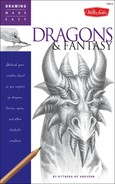In Greek mythology, centaurs represent both the best and worst of humans, being half beast and half man. Infamous for being rough and rowdy, centaurs are exceptionally prone to bouts of drunkenness. However, mythology also attributes to some of them a love of knowledge, music, and medicine—a famous centaur named Chiron was a teacher to the Greek hero, Heracles. Centaurs are also superb archers. Artistically, they present a fantastic challenge in combining two of the most difficult creatures to draw—horses and humans. But with a little patience and practice, you can put the two together and have a jolly good time doing it!

Horsing Around A slightly longer face and nose (right) will make your centaur appear more horselike. Long hair also looks good on a centaur—the hair could grow in a straight line down the scalp, like a horse’s mane (left). You can also draw horse ears.

Step 1 As always, I start by drawing the line of action and sketching the basic figure with an HB pencil. I indicate the hands so they’re raised in front of the figure—this is because I want my centaur to be plucking a lyre. I include the bony length of the tail in the sketch to give me an idea of how the rest of the tail will flow. The base of a horse’s tail is actually bone—it’s the hair that grows from the tail that makes it look long. The position of the tail can say a lot about a horse’s (and thus a centaur’s) mood—a raised tail usually means excitement or happiness.

Step 2 Now I use the HB pencil and simple shapes to develop the forms of the body. I also draw the general shapes of the hair and tail.
Step 3 I’m happy with the composition, so I start developing the shapes. I delineate the hooves and fingers, and I block in the eyebrows, nose, mouth, and pointed ears. I also draw the curved lyre between the hands.

Step 4 Now I create bangs that frame the face, similar to a horse’s forelock. I add long strokes to the hair and tail, making them appear wispy. Then I develop the face, adding the eyes and darkening the brows to make him look thoughtful. I also add the crossbar and harp pins to the lyre.

Step 5 I place my sketch on a light table and transfer the drawing to a clean sheet of paper. As I trace the lines, I decide to add a bit of scruff to the chin, making him look a bit more untamed. I also add strings to the lyre.
Step 6 Still using the HB pencil, I begin to shade areas of the centaur with light hatchmarks. I add more strokes in the hair and tail, following the direction of hair growth so the hair looks smooth and shiny. Hatching across long hair tends to make it look dull; this is fine for hair that’s in shadow, such as the hair behind the centaur’s shoulders.

Step 7 With a 2B pencil, I deepen areas of shadow with more hatching and crosshatching, switching to an HB pencil to blend the darker areas into the surrounding lighter areas with a combination of hatching and gradating. When hatching across a large area like the horse’s barrel, I make sure my strokes run crosswise across the form, changing the angle as the form curves to give it depth. Conversely, I keep the shading of the rear leg on the left very flat to suggest distance. Next I use a ruler to draw the strings of the lyre.
Step 8 I use a soft 4B pencil to push the darkest areas, also using the 2B and HB to blend the dark shadows into the lighter areas. A horse’s coat is usually very short and appears smooth from a distance, so I don’t want too much detail on the horse’s body. But I don’t want the centaur to look as if he was carved from stone, so I allow the hatching and crosshatching to imply the texture of the coat. I want the hooves to look shiny, so I use the HB to blend the dark hooves until they look smooth; then I lift out some vertical highlights with a kneaded eraser. I also use the eraser to lift out some of the tone on the fetlocks (the leg area above the hooves), defining the edges of these light areas with the HB. With the 4B, I add darks to the hair and tail, lifting out highlights with the kneaded eraser. Then I add some darker shadows to the hind legs with short, smooth strokes. After darkening the lyre, my centaur is complete.




